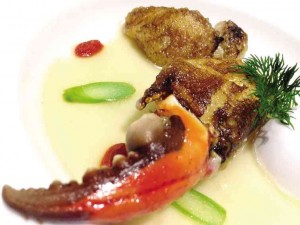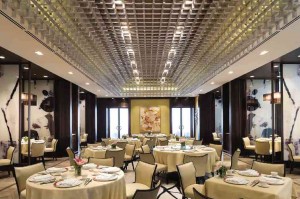
Here’s a thought for prospective buyers of condominium units in the many thrusting new skyscrapers in the city: A tall building is actually less preferable than a short one, unless you’re willing to pay the dizzying prices for an upper-story floor.
If you’re going to live on the seventh floor, however, it’ll benefit you to be in a building with only seven floors, rather than 71. Otherwise you’ll spend most of your time waiting for elevators, but without the benefits of a plutocratic view.
Penthouse floor restaurants tend to be associated with sky-high prices but mediocre food; you go there to feed your ego, not your stomach. As the construction cranes are dismantled and interiors fitted, not a few rooftop or penthouse bars and dining places have opened their doors in buildings that are, like the Death Star, not quite finished but fully operational.
One building that went up with great stealth is the Marco Polo Hotel in Ortigas, which I had no idea existed until a friend invited us there for a degustation at its flagship Chinese restaurant, Lung Hin on the 44th floor.
Service was brisk and efficient; we were quickly ushered from the already serene main dining room into a noise-proof function room, which had a window view of the city, as well as a TV set in case you suddenly get bored of your friends.
Sophistication
At the helm of this palace is a highly enthusiastic Cantonese chef named Yeungkwan Cheng, who rattled off his resume: Through his heavily accented English we caught the names of several five-star hotel outlets, and the words “Michelin star” several times.
His food is as idiosyncratic as it is refined—throughout the meal I kept wondering if Manila, and even I, was ready for this kind of sophistication.
We’ve gotten used to Chinese techniques and flavors creeping into Filipino and Western cuisine, from the pritchon craze (using lechon skin to make Peking duck-like wraps), and even European chefs use stir-fry techniques or hoisin sauce. But to have fusion go the other way around takes some getting used to.
I’ve sampled a few attempts at fusion or experimental Chinese food and have liked some, more than others; yet every time, I’ve thought, this is great, but it’s not Chinese.
Lung Hin is the same; it strains one’s purist, reactionary idea that Chinese food should be limited to Asian ingredients and traditional techniques.
The only land-based meat was to be found in the appetizers—a perfectly executed square of roast suckling pork and minced pork inside a leek roll. That was it.
The rest of the evening was purely aquatic, starting with the entrée, Cheddar Lobster, which was essentially an Italian-style cream-based pasta with cheddar instead of of parmesan, and generous bits of lobster. There was nothing Chinese about it, but who cares? It was delicious.
A crabmeat couscous soup returned us firmly to the Orient, and the grains of couscous added texture in the way that grains of millet or sorghum would have. But the chef had chosen couscous.
This blended a bit too seamlessly with the main course, a crab claw, deep-fried, with egg whites. The meal galloped to an end with stir-fried Chinese broccoli (imported from Hong Kong), dried scallop fried rice, and avocado sago.
My first and main criticism of the dinner was that, at the most basic level of sheer volume, I didn’t get full. But this is perhaps a problem of my gluttonous side, rather than the restaurant’s.
Odd pacing
On a more conceptual level, the pacing of the degustation was odd: a top-heavy entrée with cream and cheese, and then a main course that was overly timid, it left us wanting.

In such cases, a second main course, also not too large, was usually in order; perhaps something amphibious like fowl to bridge the balance between land- and sea-based meats.
Another problem with sticking mainly to a crustacean-based menu is the monotony of texture that pervades the meal, even if the flavors change from course to course.
I would hate to see the chef’s hands creatively tied by forcing him to cook in a more orthodox fashion; he was hired, after all, to bring a new kind of Chinese food to the city, or at least new kinds of food to the Chinese restaurant.
His technique is beyond reproach, as is his generosity with fresh and often expensive ingredients. But those accustomed to a groaning lazy Susan may find the Western-style service à la russe disconcerting. Apart from the degustation, there were more conventional items, as well as less ambitious experiments, on the à la carte menu.
Despite all these caveats, I would recommend Lung Hin, if only for the 44th floor view and tasting something different from most Chinese food in the city.
Purists beware, but for those with adventurous palates, there are explorations here worth undertaking.
Lung Hin is at 44/F Marco Polo Ortigas, Meralco Avenue and Sapphire Street, Ortigas Center, Pasig. Call 7207777.















































